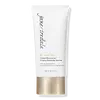Estée Lauder Double Wear Stay-in-Place Foundation Versus Jane Iredale Dream Tint Tinted Moisturizer SPF 15
What's inside
What's inside
 Key Ingredients
Key Ingredients

 Benefits
Benefits

 Concerns
Concerns

 Ingredients Side-by-side
Ingredients Side-by-side

Water
Skin ConditioningCyclopentasiloxane
EmollientTrimethylsiloxysilicate
EmollientPEG/PPG-18/18 Dimethicone
EmulsifyingButylene Glycol
HumectantTribehenin
EmollientPolyglyceryl-3 Diisostearate
EmulsifyingMagnesium Sulfate
Tocopheryl Acetate
AntioxidantPolymethylsilsesquioxane
Methicone
EmollientLaureth-7
EmulsifyingXanthan Gum
EmulsifyingAlumina
AbrasiveSodium Dehydroacetate
PreservativeDisteardimonium Hectorite
StabilisingCellulose Gum
Emulsion StabilisingPropylene Carbonate
SolventPentaerythrityl Tetra-Di-T-Butyl Hydroxyhydrocinnamate
AntioxidantPhenoxyethanol
PreservativeIron Oxides
Mica
Cosmetic ColorantCI 77891
Cosmetic ColorantWater, Cyclopentasiloxane, Trimethylsiloxysilicate, PEG/PPG-18/18 Dimethicone, Butylene Glycol, Tribehenin, Polyglyceryl-3 Diisostearate, Magnesium Sulfate, Tocopheryl Acetate, Polymethylsilsesquioxane, Methicone, Laureth-7, Xanthan Gum, Alumina, Sodium Dehydroacetate, Disteardimonium Hectorite, Cellulose Gum, Propylene Carbonate, Pentaerythrityl Tetra-Di-T-Butyl Hydroxyhydrocinnamate, Phenoxyethanol, Iron Oxides, Mica, CI 77891
Titanium Dioxide 5%
Cosmetic ColorantWater
Skin ConditioningStearic Acid
CleansingCaprylic/Capric Triglyceride
MaskingOctyldodecyl Neopentanoate
EmollientLeuconostoc/Radish Root Ferment Filtrate
AntimicrobialLactobacillus Ferment
Skin ConditioningGlycerin
HumectantGlyceryl Stearate
EmollientSimmondsia Chinensis Seed Oil
EmollientGlyceryl Acrylate/Acrylic Acid Copolymer
HumectantSpirulina Platensis Extract
Skin ProtectingHydrolyzed Rhodophyceae Extract
Carthamus Tinctorius Seed Oil
MaskingHelianthus Annuus Seed Oil
EmollientSambucus Nigra Extract
Skin ConditioningBoron Nitride
AbsorbentMica
Cosmetic ColorantButyrospermum Parkii Butter
Skin ConditioningCamellia Sinensis Leaf Extract
AntimicrobialVitis Vinifera Seed Extract
AntimicrobialPunica Granatum Extract
AstringentLavandula Angustifolia Oil
Masking1,2-Hexanediol
Skin ConditioningPolyhydroxystearic Acid
EmulsifyingAlumina
AbrasiveLinalool
PerfumingLimonene
PerfumingGeraniol
PerfumingCI 77489
Cosmetic ColorantCI 77491
Cosmetic ColorantCI 77492
Cosmetic ColorantCI 77499
Cosmetic ColorantCI 77288
Cosmetic ColorantTitanium Dioxide 5%, Water, Stearic Acid, Caprylic/Capric Triglyceride, Octyldodecyl Neopentanoate, Leuconostoc/Radish Root Ferment Filtrate, Lactobacillus Ferment, Glycerin, Glyceryl Stearate, Simmondsia Chinensis Seed Oil, Glyceryl Acrylate/Acrylic Acid Copolymer, Spirulina Platensis Extract, Hydrolyzed Rhodophyceae Extract, Carthamus Tinctorius Seed Oil, Helianthus Annuus Seed Oil, Sambucus Nigra Extract, Boron Nitride, Mica, Butyrospermum Parkii Butter, Camellia Sinensis Leaf Extract, Vitis Vinifera Seed Extract, Punica Granatum Extract, Lavandula Angustifolia Oil, 1,2-Hexanediol, Polyhydroxystearic Acid, Alumina, Linalool, Limonene, Geraniol, CI 77489, CI 77491, CI 77492, CI 77499, CI 77288
 Reviews
Reviews

Ingredients Explained
These ingredients are found in both products.
Ingredients higher up in an ingredient list are typically present in a larger amount.
Alumina is another name for the compound aluminum oxide. It is used as a thickener, absorbent, and abrasive.
As an absorbent, alumina can give a mattifying effect. It is used in mineral sunscreens to help coat nano-sized filters, such as titanium dioxide. By increasing the size of the UV filters, these ingredients stay on the skin for a longer time. By coating small sized ingredients, alumina helps thicken a product.
Alumina may be used as an abrasive, or exfoliant.
Alumina is naturally occurring in the mineral corundum. Certain varieties of corundum create rubies and sapphires. Corundum is also the crystalline form of alumina.
Learn more about AluminaMica is a naturally occurring mineral used to add shimmer and color in cosmetics. It can also help improve the texture of a product or give it an opaque, white/silver color.
Serecite is the name for very fine but ragged grains of mica.
This ingredient is often coated with metal oxides like titanium dioxide. Trace amounts of heavy metals may be found in mica, but these metals are not harmful in our personal products.
Mica has been used since prehistoric times throughout the world. Ancient Egyptian, Indian, Greek, Roman, Aztec, and Chinese civilizations have used mica.
Learn more about MicaWater. It's the most common cosmetic ingredient of all. You'll usually see it at the top of ingredient lists, meaning that it makes up the largest part of the product.
So why is it so popular? Water most often acts as a solvent - this means that it helps dissolve other ingredients into the formulation.
You'll also recognize water as that liquid we all need to stay alive. If you see this, drink a glass of water. Stay hydrated!
Learn more about Water